When it comes to unique Japan experiences, there is perhaps no better way to immerse yourself in traditional Japanese culture than with a stay at an authentic and luxurious ryokan in the countryside.
But for non-Japanese travelers, there can be quite a few surprises when staying at a ryokan (Japanese-style inn), because it’s very different from staying at a hotel. In this comprehensive guide to experiencing a ryokan stay in Japan we’ll:
- Highlight key differences between hotels and ryokans
- Walk you through exactly what to expect at a traditional ryokan
- Explain ryokan and onsen (hot springs) etiquette
- Discuss the amazing food, one of the highlights of staying at a ryokan
- Ryokan 101: Experience a Ryokan (and Onsen) Like a Local
Throughout this post, you’ll also find examples of some of our absolute favorite ryokans around the country. So for an insightful introduction to ryokans in Japan, read on! (If you’re looking for a shortcut, watch our “virtual ryokan tour” below on what to expect when staying at a Japanese ryokan.)
Originally written in 2014, this post was updated and republished on March 6, 2020.
Key Differences Between Ryokans & Hotels
What is a ryokan?
Ryokans are traditional Japanese inns where travelers can experience authentic Japanese culture. It begins on arrival when you trade in your shoes and clothes for slippers and a comfortable yukata robe. Relax over green tea in your tatami mat room, soak in the onsen (hot springs), and enjoy seasonal kaiseki cuisine.
Before we dive into more detail, here are some of the key differences between a ryokan and a hotel:
- Your minimalistic tatami-mat room
- Trading in your shoes and street clothes for yukata (a Japanese-style robe) and slippers
- Soaking in healing onsen (hot springs)
- Your multi-course kaiseki dinner and beautiful Japanese breakfast
- Traditional Japanese futon bedding (sometimes misleadingly referred to as “sleeping on the floor”)
Japanese Ryokan Basics
Imagine if someone asked you, “What are hotels like?” If you’ve stayed at various hotels around the world, chances are you’d answer, “Well, it depends.”
Ryokans in Japan come in all shapes and sizes, and — as with hotels or inns in any country — every ryokan is different. Most are on the small side, but some are larger. There are highly luxurious ryokans where you’ll experience the best in Japan luxury travel, as well modest properties more akin to humble country inns. (There are also minshuku, which are “basic” ryokan-like properties where food is not always included).
Locals tend to associate ryokans with the Japanese countryside – and from our perspective heading to rural Japan is the quintessential way to experience a ryokan stay. Japanese city dwellers retreat to rural ryokans to relax and rejuvenate for a couple of days. Grounds are usually serene, with an emphasis on nature and beautiful gardens, or views of surrounding streams and mountains.
But Kyoto, Kanazawa, and other Japanese cities are also home to some beautiful, traditional ryokans (even Tokyo has a handful), so if you’re eager to experience an “urban” ryokan, it is certainly possible.
Because ryokans can be as eclectic as hotels, not everything we mention in this article necessarily applies to every single ryokan. But you will get an extremely helpful and detailed overview of what it’s usually like to stay at a ryokan in Japan, and it all begins with your arrival — usually via Japan’s wonderful rail system!
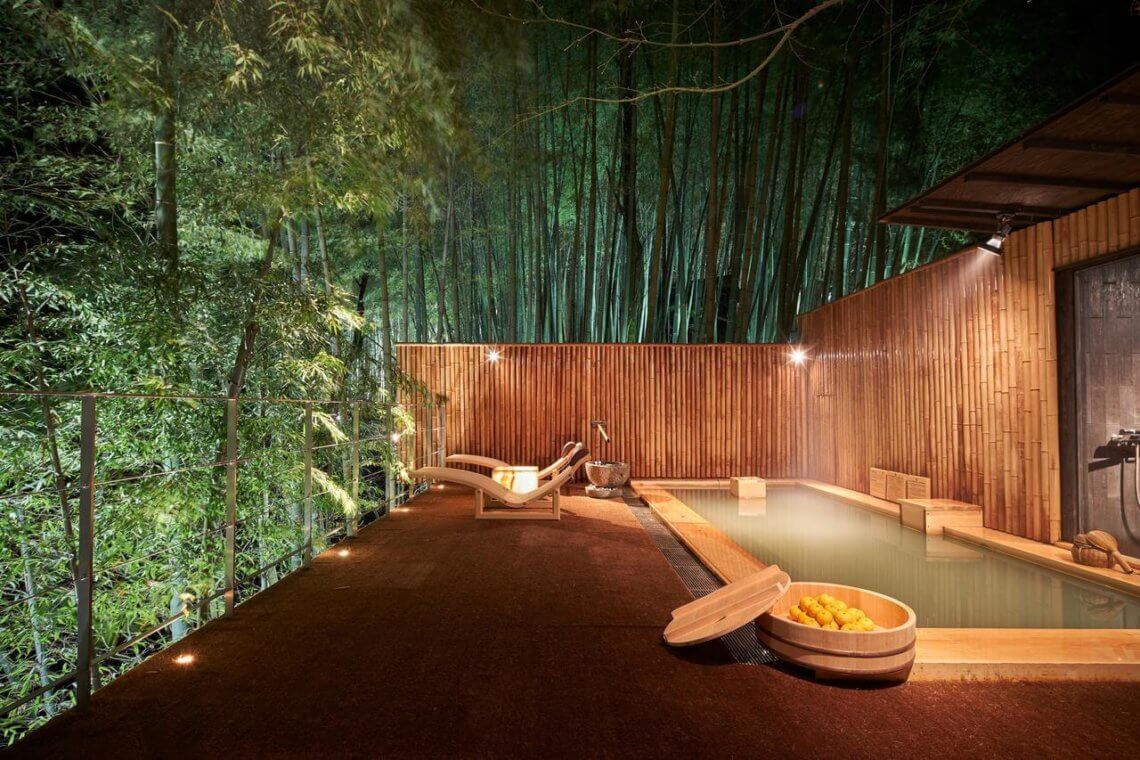
Arriving At Your Ryokan
You made it! Upon entering your ryokan, staff will greet you and show you where to remove your shoes (using gestures and sign language, if needed). You’ll then slip on the slippers that have been provided for you.
While large ryokans abound, it’s very common for ryokans to be on the smaller side. They’re often family-run, and in many cases have been handed down generation to generation.
Check-in formalities, particularly at smaller ryokans, are usually much quicker and simpler than at hotels. You’ll be led to your room by the nakai-san (your room attendant), who will politely show you the way.
When you get to the room, you’ll take your slippers off – you don’t wear slippers on tatami mats (just wearing socks is recommended). If you’re not sure when to take your slippers off, the nakai-san will be happy to show you. She or he will show you to your yukata (light robe). For the full Japanese experience, change into yukata as soon as they leave the room. You’ll be wearing these comfortable robes for the duration of your stay!
Typically, you’ll find a lovely seasonal wagashi (Japanese sweet) on the room’s central table, and your nakai-san will prepare your first cup of local tea for you. You don’t need to do anything – just enjoy the hospitality and the aromatic smell of the tatami mats.
Before your nakai-san leaves the room, ask them to show you how to operate the electric hot water kettle, your room’s thermostat, and the Japanese toilet (with all its buttons), since instructions for these are not always available in English.
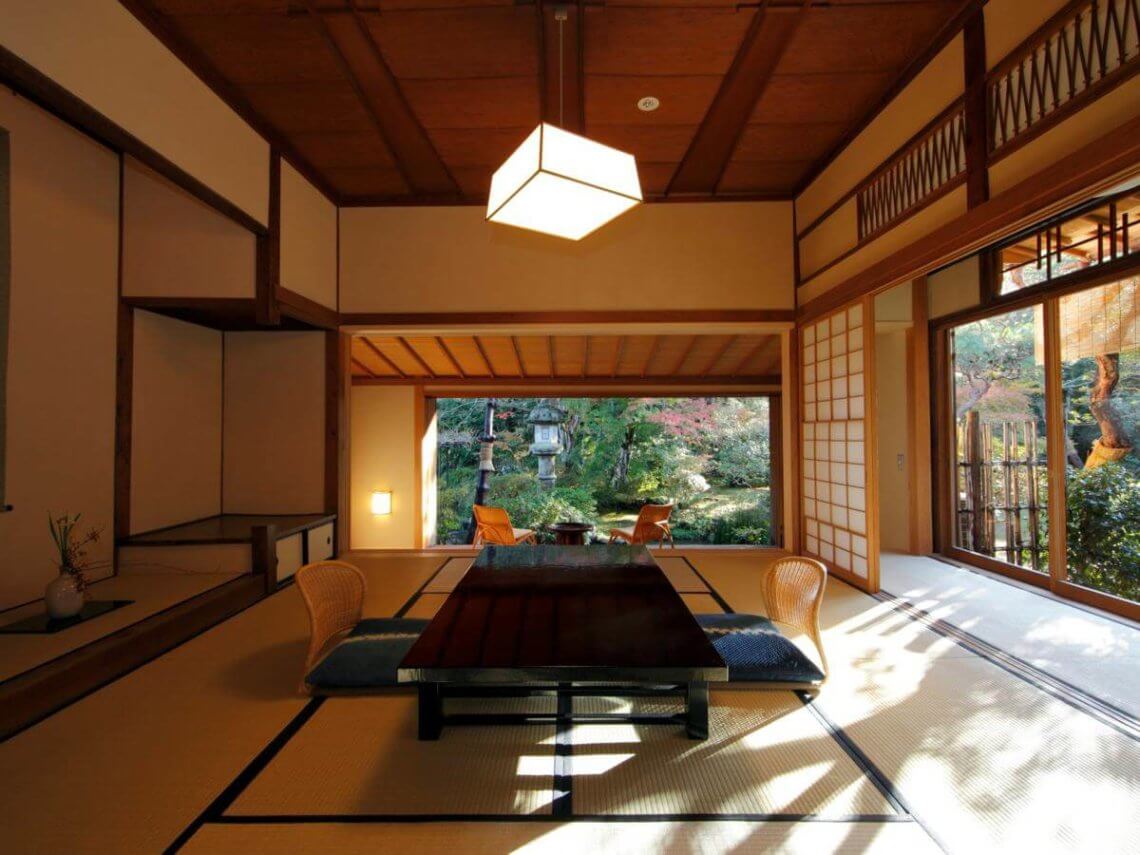
Rooms at a Traditional Ryokan
When entering your traditional Japanese-style room, you may be surprised at what you find – or don’t find!
In contrast with hotel rooms, the rooms at traditional ryokans are, shall we say, “Zen.” They typically lack much furniture, apart from a low central table with zaisu (legless chairs). (At some ryokans, you may have additional furniture, and certainly some high-end and modern ryokans feature a variety of seating options.)
The flooring is traditionally tatami matting, which is both aesthetically pleasing and comfortable to walk, sit, or lay on. But you may be wondering: where are the beds? Don’t worry, we will go over traditional Japanese-style bedding below.
As for the bathrooms: if you’re staying at a luxury ryokan, you’ll have your own private en suite bathroom, as you would expect at any high-end accommodations.
But at many rustic ryokans (even at some moderately luxurious ones), your room may not have an en suite bathroom. Understandably, this is a concern for many travelers, so if you have any doubt make sure to ask before selecting a property.
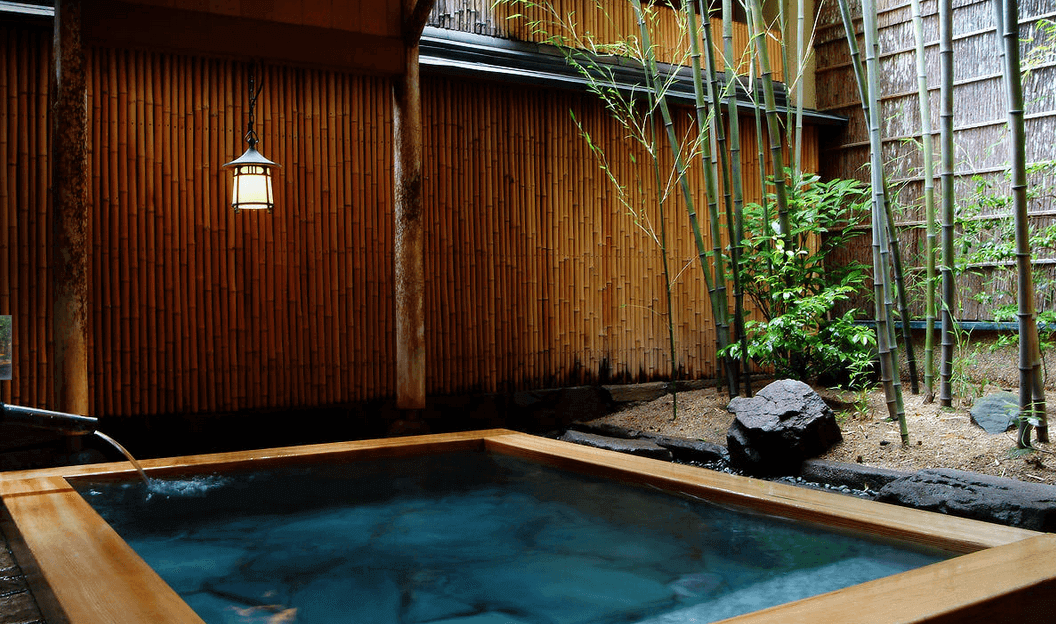
Bathing at Ryokans: Onsen (Hot Springs)
Bathing is an important part of Japanese culture, and perhaps nothing is more enjoyable – and potentially confusing – to non-Japanese travelers than the hot springs experience at a ryokan. Hot springs are common in many countries, but what makes Japan unique is the onsen culture, which blends an appreciation of nature with a sophisticated philosophy.
We’ve included some helpful tips so you can enjoy your experience to the fullest. But it’s best to accept that, no matter how much you prepare, you’ll probably make an etiquette mistake (or two).
Don’t worry! Japanese people are very understanding. The key is to always just be respectful, and if you don’t know what to do, ask (even sign language works).
Don’t miss our full article on Japanese etiquette for more on tips and taboos for your travels.
Onsen “101”: Japanese Hot Springs Basics
In addition to the traditional hospitality, and the food, onsen are one of the biggest reasons travelers make the journey to rural ryokans.
Not all ryokans have natural hot springs, but even those without onsen will offer a traditional bathing experience, and the etiquette tips below also apply.
Visiting a Japanese onsen is therapeutic, relaxing, and culturally fascinating. It can be a little confusing the first time, but once you get the system down it’s both fun and incredibly rejuvenating.
Onsen & Bathing Etiquette Tips
These tips apply to both onsen and to regular baths.
What to Wear at onsen in japan
This one’s easy: nothing. Most onsen are gender-separated, although a small handful are communal. Regardless, swimsuits are simply not permitted. If this sounds unappealing to you, another option is private onsen, a great solution for many travelers (more on this below).
make sure to bathe before entering the onsen
When visiting an onsen, you’ll first pass through a changing room. Disrobe and place your garments (everything but your small onsen towel) in the basket provided. Then continue into the shower area, where you’ll find shampoo and body wash. Once you have thoroughly cleaned up, it’s time to soak in the onsen itself.
small and large onsen towels
At onsen, you always have two towels: one large and one small. The large one is for fully drying off after your relaxing soak (leave it in your changing room basket). Take the small towel with you out to the onsen, however it’s important to not let the towel touch the water. Most people use the little towel to discreetly cover themselves while walking from the shower area to the onsen, and then place it on their head, tie it around their forehead, or lay it somewhere near the edge of the bath. Just make sure to keep it out of the onsen.
CAN PEOPLE WITH Tattoos ENTER ONSEN?
Tattoos are not as common among Japanese people as they are in Europe or North America, and traditionally tattoos have been seen as symbols of the Japanese underworld. Because of this, many ryokans have rules against people with tattoos. While this doesn’t always apply to non-Japanese guests (some ryokans choose to be extra flexible), if you have a tattoo — and a Japanese guest complains — you may be asked to leave the bath. If possible, cover your tattoo with a bandage. If this is not possible, the best solution may be to select a ryokan with private onsen — fortunately, these are quite common!
Drinking IN ONSEN
During the day, it is widely considered uncouth to imbibe in onsen. At night, however, it is common at some (though definitely not all) ryokans to see people consuming nihonshu (sake) while bathing. Be very careful: the combination of drinking and onsen-bathing can be dangerous. Also, be respectful: being rowdy is a surefire way to be booted from an onsen.
Types of Indoor & Outdoor Onsen (Shared & Private)
Indoor Onsen
Most onsen have one or more indoor baths, and these are usually gender-separated. At some onsen, the indoor bath is actually the main attraction, whether due to its history, architecture, or views. A great example of this is the historic Chojukan Hoshi Onsen in Gunma Prefecture.
Rotenburo (Open-Air Bath)
Bathing in onsen while feeling the refreshing mountain air is as amazing as it sounds. At some onsen, the rotenburo (open-air onsen) are gender-separated, while others offer mixed (kon’yoku) bathing. For example, Tsurunoyu in Akita Prefecture has an iconic kon’yoku rotenburo, which is at its most magical in the dead of winter. There is nothing quite like soaking in a remote onsen in the middle of the snowy woods. (Read a very interesting short interview with Kazushi Sato, the owner of Tsurunoyu Onsen.)
Gender-Separated Onsen
These days, most onsen are gender-separated, to the chagrin of many onsen purists. If you’d like to be able to share the onsen experience with your opposite-gender partner, family member, or friend, you’ll need one of the following:
- Mixed bathing (kon’yoku) onsen
- Private in-room onsen
- Kashikiri (private rental) onsen
Kon’yoku Onsen (Mixed Bathing)
Some traditional onsen are for everyone, regardless of gender. These are ideal if you’re going with family or friends of the opposite gender. Although for some it can be intimidating at first, keep in mind that everyone is focused on the onsen and surrounding scenery! And while you do bathe in the nude, you are provided with a small towel to cover up as you head from the changing room to the onsen.
Private In-Room Onsen
Many luxury (and even some mid-range) ryokans offer rooms with private onsen. Sometimes the onsen is a beautiful hinoki wooden bath within a spacious bathing area. At some ryokans, you may have a large stone rotenburo (open-air bath) overlooking a garden. Booking a room with private onsen is ideal for honeymoons or romantic getaways, or for families with young kids.
Kashikiri Onsen (Private Rental Onsen)
Many ryokans offer kashikiri onsen, private baths available through advance booking. Often, they can be booked by the hour and are open to anyone: couples, families, or groups of friends. Some ryokans charge extra for kashikiri onsen, while at many ryokans it’s complimentary. At most ryokans, you can reserve kashikiri onsen after check-in.
Higaeri Onsen (Day-Use Onsen)
Higaeri onsen are onsen that can be used by non-guests. Some ryokans offer a day-use option, though many do not.
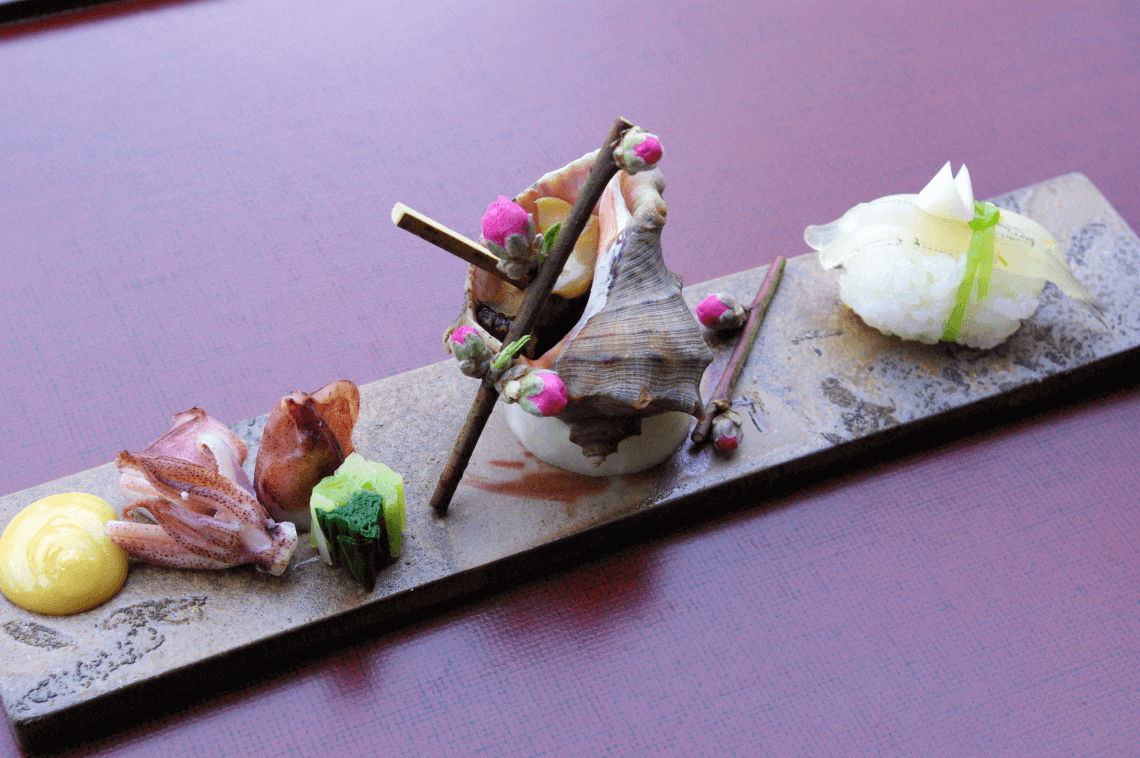
Food & Dining at Ryokans
When staying at a ryokan, your main “tasks” are to soak in onsen, contemplate nature, drink green tea in your tatami-lined room, and partake of incredible, memorable meals.
Japanese cuisine is an integral part of the ryokan experience, and for most people one of the highlights. Most ryokan stays include breakfast and a kaiseki dinner, both of which typically feature a beautifully presented and colorful array of local and seasonal specialties.
These beautiful feasts are an unforgettable culinary experience, and a great way to sample Japanese foods you may never get to experience again. The kaiseki dinner is a multi-course affair, served either in the privacy of your room, or (at many ryokans) in a dedicated dining area. Be sure to bring your appetite.
While every ryokan is different, dinners usually feature:
- Local vegetables, grown and foraged
- The bounty of the sea or local rivers
- Local meats or wild game
- The staples of Japanese food, such as miso soup and wonderful local rice
- Dessert, which may mean ice cream or stunning seasonal fruit
Pair your divine meal with drinks such as local sake or shochu, beer, wine, or tea.
Breakfasts are just as colorful, especially if you opt for Japanese breakfast (some, though not all, ryokans offer a western option too). A traditional Japanese breakfast usually features grilled fish, rice, miso soup, omelette, and more. At ryokans that offer a western option, expect eggs, toast, and coffee.
A special note on dietary restrictions: if you have any food allergies or other essential needs or requests, make sure to let the ryokan know at the time of booking. Ryokans plan their meals well in advance and cannot typically accommodate last-minute requests.
Following your magnificent dinner, the evening is yours to relax, have a drink, soak in the onsen, or perhaps have an early night.
Which brings us to our final topic: Japanese-style futon bedding.
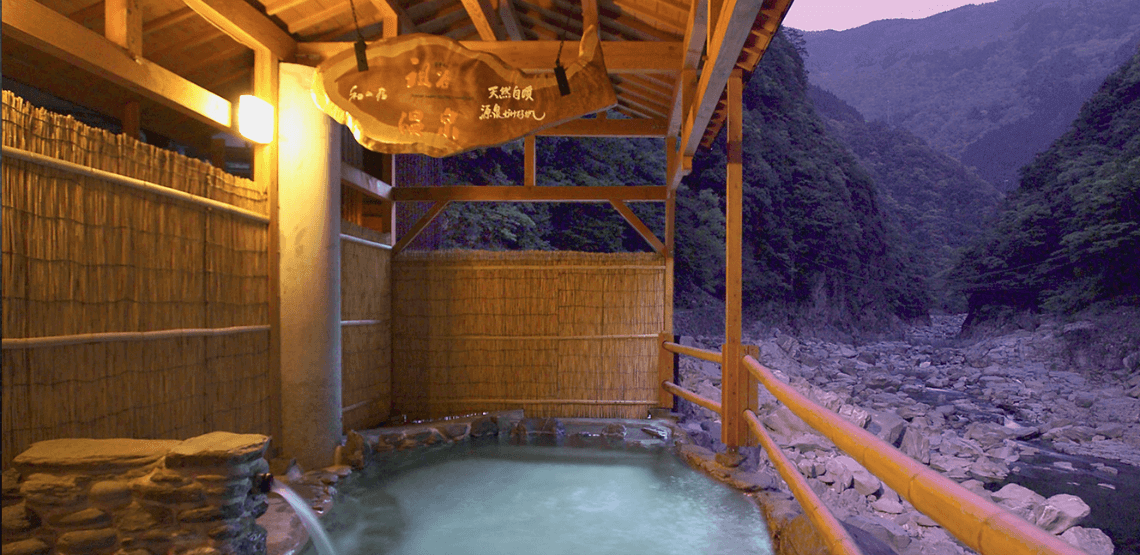
Japanese-style Futon Bedding
The word futon is originally a Japanese word, and refers to the type of bedding you’ll experience at most ryokans. Don’t be misled by the word, as Japanese-style futon are quite unlike futons in Europe or the Americas!
Bedding is not usually present in your room during the day, but while you are enjoying your kaiseki dinner feast, ryokan staff will discreetly visit your room and prepare your traditional bedding for you.
Particularly at luxury ryokans, you can expect wonderfully plush and comfortable bedding, making for an extremely restful night of sleep for most travelers.
However, if you are concerned about this type of sleeping arrangement, it’s worth noting that many high-end ryokans have begun incorporating western-style elements, such as offering rooms with western-style beds. If having a western-style bed is a priority for you, simply take this into account when selecting a ryokan.

Ryokan 101: Experience a Ryokan (and Onsen) Like a Local
We hope our detailed article and video help you have a truly magical ryokan experience.
The article above is full of details, but if you’re just looking for the highlights, here is virtually everything you need to know to experience a Japanese ryokan like a pro. Now get ready to relax!
- Arrive and be welcomed by ryokan staff, who will have you take off your shoes and lead you to your room.
- As you sit at a low traditional table in your room, your nakai-san (attendant) will bring you a cup of tea and seasonal wagashi (traditional sweet).
- They’ll show you around the room, and ask questions such as what time you’d like to have dinner and breakfast, and whether you’d like a Japanese or Western breakfast (the details vary from ryokan to ryokan). Don’t be afraid to ask questions. If they don’t speak English, use sign/body language.
- After they leave, it’s time for your first onsen experience! In your room you’ll find a yukata (robe). Here’s how to put it on.
- If your room doesn’t have its own onsen, put on the yukata and head to the baths. Ask staff if you’re not sure where they are, or if you’re not sure which is for which gender.
- Upon entering the bath area, you’ll see a changing room. Disrobe completely and put your garments in the provided baskets (it’s probably best to leave items such as your phone in your room, since you shouldn’t take pictures of the bath/bathers).
- Proceed to the low showers, where you’ll sit and thoroughly clean yourself before entering the onsen. Be thorough.
- Soak in the onsen to your heart’s content.
- After your first bath experience, enjoy downtime before dinner. Stroll around the property in yukata, relax or take a nap in your room, drink tea or beer or local sake. Take it easy and prepare for a big meal (unless you’re a very big eater, best arrive hungry)!
- Dinner will be in your room or in a dining area. Staff will inform you, but don’t be afraid to ask if you’re not sure. At most ryokans, dinner is included but drinks are extra. Expect to linger over your multi-course dinner for anywhere from one to two hours or so.
- After dinner, head to the bar if there is one (many ryokans are small and don’t have bars), or retire to your room. It’s very common for people to bathe in the onsen after dinner. At some ryokans the baths shut around midnight, while at some they’re open very late or all night.
- While you’re at dinner, staff will set up your traditional Japanese-style futon bedding. It’s not uncommon for guests to be ready for a wonderful sleep after onsen and dinner.
- If you love onsen, rise early to bathe before others have woken up. There’s nothing more magical.
- Prepare for a filling breakfast, which will be particularly healthy if you’ve chosen Japanese style. Wear yukata for the full experience.
- If you’re staying longer, it’s time to relax. If you’re checking out and have had a particularly excellent stay, you may tip your attendant, placing clean bills within an envelope (or even nicely folded paper). Tipping is not common in Japan, but is not uncommon in this scenario (though definitely not required).
- Begin planning your next ryokan stay!

Immerse Yourself in an Extraordinarily Unique Experience
Whether you usually plan your own trips, or normally work with a destination expert, planning a trip to Japan can seem overwhelming at times.
At Boutique Japan, our specialty is crafting completely customized trips for travelers seeking unique, authentic experiences.
If you are interested in learning more about working with us, please feel free to explore our trip planning process.


